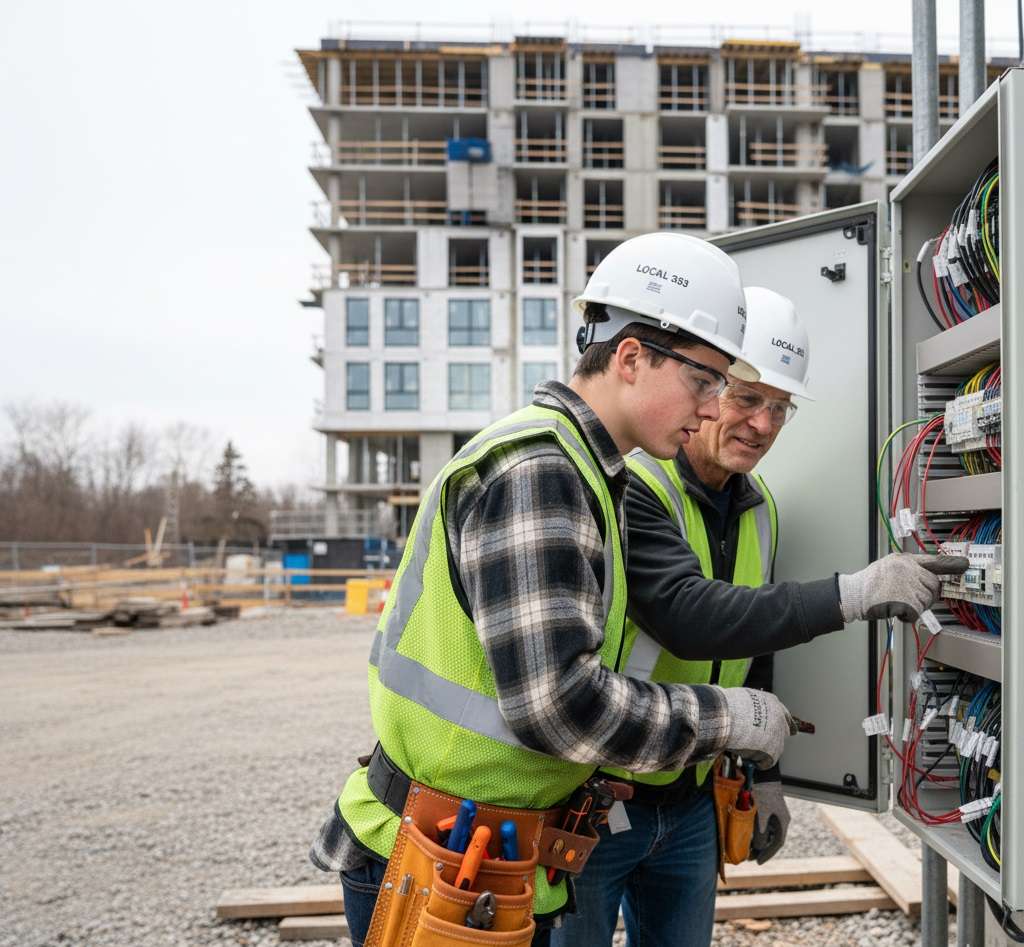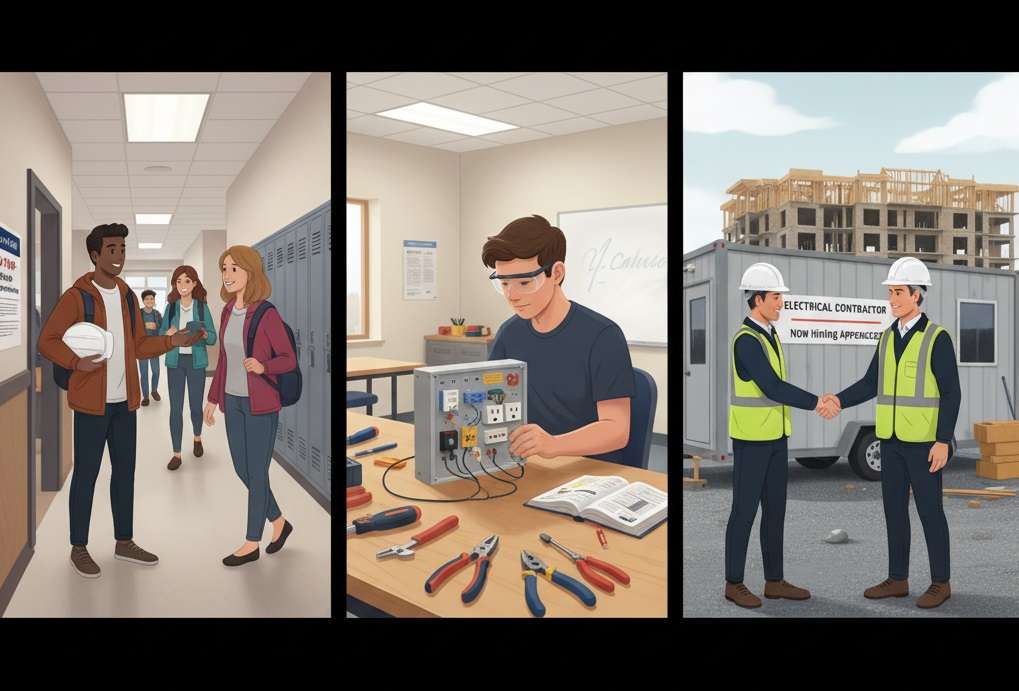Picture a cold February morning on a condo site in Mississauga. A first-year apprentice is on a ladder, trying to pull cable through stubborn conduit while the journeyperson on the ground reminds them to “keep the bend gentle, not angry.” By lunchtime they’re in the job trailer, boots thawing by the heater, arguing about the best way to wire a three-way switch.
That’s what an electrician apprenticeship in Ontario really feels like: part workout, part puzzle, part code book. If you like working with your hands, solving problems, and you don’t mind heights or tight spaces, the 309A Electrician — Construction and Maintenance trade can be a very steady way to build a career.
You don’t need a university degree. You do need a sponsor employer, thousands of hours of logged work, several rounds of trade school, and a final exam. This guide walks you through how people in Ontario usually become licensed electricians, without the fluffy sales talk.

What 309A electricians actually do in Ontario
A 309A Construction and Maintenance electrician is the person making sure buildings don’t go dark, breakers don’t trip all day, and equipment starts when it’s supposed to. In Ontario, that can mean:
- New housing developments in Brampton
- Office towers in downtown Toronto
- Solar farms north of Barrie
- Industrial plants in places like Hamilton or Windsor
Day to day, you might:
- Read drawings and the Electrical Safety Code
- Run conduit and cable, install panels, breakers, and lighting
- Diagnose why a machine keeps blowing fuses
- Work with other trades so everything fits in tight ceilings and mechanical rooms
It’s a compulsory Red Seal trade, which means in Ontario you must be a registered apprentice or licensed journeyperson to legally do this work. The standard apprenticeship is 9,000 hours of combined jobsite and in-school training, which usually works out to about five years of real time, give or take depending on how steady your hours are.
Getting yourself “apprentice-ready”
Before you think about forms and portals, it helps to check two things: your basic requirements and your temperament.
Basic requirements
Most Ontario apprentices have:
- At least Grade 12, with solid math
- Legal right to work in Canada
- Enough English to follow safety talks, code books, and college classes
Technically, some older material mentions Grade 10 as a minimum, but in practice employers and unions prefer a full high school diploma, especially for 309A. If you’re still in school, treat math and physics as tools you’ll actually use, not just marks to survive.
Temperament check
You’ll probably be okay in this trade if:
- You don’t mind getting dirty or working outdoors in January
- You can focus on small details (wire sizes, torque values, code rules)
- You like puzzles and aren’t scared of formulas once you see how they’re used
- You’re willing to climb ladders, carry material, and take safety seriously
If that still sounds appealing, you’re likely a better fit than someone who only likes desk work.
Common ways people in Ontario get started

There isn’t just one path into the trade. In Ontario you usually see three main starting points.
1. High school co-op or OYAP
If you’re in Grade 11 or 12, ask your guidance office about:
- Co-op placements with electrical contractors
- The Ontario Youth Apprenticeship Program (OYAP)
In a good co-op, you’re not just sweeping floors. You might be:
- Pulling wire
- Helping install boxes and devices
- Watching how the journeyperson reads drawings and solves problems
Some of those hours can later be counted toward your apprenticeship if you stay with that employer. It’s also the cheapest way to discover you don’t like the trade, before you spend money on college.
Read: Cybersecurity certifications in Ontario
2. Pre-apprenticeship or Electrical Techniques at college
A lot of people finish high school, work a bit, then decide to try a short college program such as:
- Electrical pre-apprenticeship
- Electrical Techniques (often 1 year or less)
These programs usually cover:
- Tool use and safety
- Basic circuits and theory
- Intro to the Electrical Code
- Small residential projects in the lab
Benefits:
- You get comfortable with terminology before stepping on a busy job site
- You meet instructors and classmates who may already know contractors
- In some cases, your in-class hours can be credited toward your 9,000 apprenticeship hours
This route makes sense if you don’t have family in the trades or you’re switching careers from something very different, like retail or office work.
Read: Building Credit as a Student in Ontario
3. Direct hire by a contractor or union
You can also go straight to employers:
- Electrical contractors (residential, commercial, industrial)
- Union offices (like IBEW locals)
- Facility maintenance departments
You start as a helper or junior worker and, if they see you’re serious and show up on time, they may agree to sponsor you as an apprentice. This works best if you’re comfortable learning fast on the job and don’t mind being the new person who asks a lot of questions.
Read: Software for Students in Ontario
Registering with Skilled Trades Ontario (the not-so-fun paperwork)
You are not officially an apprentice just because you pulled wire all summer. The key step is getting registered with Skilled Trades Ontario (STO).
In simple terms, this looks like:
- Find a sponsor employer
Someone who is allowed to train apprentices — usually a licensed electrician, contractor, or company. - Sign a Training Agreement
Your employer starts the process with STO (often online). You sign off as the apprentice. - Get your apprenticeship ID and training standard
STO sends you documents that:- Confirm you’re registered in the 309A Construction and Maintenance trade
- List the tasks and skills you’re expected to learn over the 9,000 hours
- Start logging hours properly
Your employer will keep records, but you should track your time too: job types, dates, and what you worked on. That tracking matters later when you’re almost ready for your exam.
This step is boring but important. Without it, you’re just “the electrical helper” — not someone on a formal path to a licence.
Read: Renting First Apartment in Ontario
What the 9,000 hours actually look like
Those 9,000 hours are a mix of work and school. A rough breakdown:
- Around 8,000+ hours working with a sponsor
- Around 800–900 hours in trade school across several levels
On the job, your progression usually feels like this:
- First year: Lots of lifting, drilling, pulling cable, cleaning up, and basic terminations under close supervision.
- Middle years: Reading more drawings, doing rough-in work, installing panels and devices, being trusted to “rough a unit” or “finish a floor” with a partner.
- Later years: Troubleshooting, more complex feeders and controls, planning work, and sometimes guiding newer apprentices.
Trade school comes in short, intense blocks (roughly 8–10 weeks at a time). You leave the job site, sit in a classroom, and live in your code book. Levels cover electrical theory, code rules, prints, motor controls, and more advanced systems.
How pay usually grows
Most Ontario employers pay apprentices as a percentage of a journeyperson’s wage. Every agreement is different, but a common pattern looks like:
- Early apprentice: around 40% of the journeyperson rate
- Mid-apprenticeship: around 60%
- Near the end: around 80%
So if the journeyperson base in your area is, for example, $50/hour, an apprentice might climb from about $20/hour at the start to about $40/hour by the end of the apprenticeship. The numbers will vary, but the general “rising percentage” pattern is consistent.
Writing the 309A Certificate of Qualification exam
Once your hours are logged and your in-school levels are done, STO will let you apply to write the Electrician — Construction and Maintenance (309A) Certificate of Qualification exam.
This exam is heavily based on:
- The Electrical Code
- Calculations (loads, sizing, voltage drop)
- Practical trade knowledge
Most apprentices treat exam prep like a short, intense season:
- Re-doing college practice questions
- Taking a dedicated pre-exam course at a college or training centre
- Spending a lot of evenings with code book tabs and a calculator
Pass the exam and you receive your C of Q. With that, you can work as a licensed journeyperson in Ontario and, with Red Seal endorsement, have mobility across much of Canada. Down the road, some people also go on to get their Master Electrician and run their own contracting business.
Read: Ontario Apprenticeship Guide: skilled trades step-by-step
Quick path recap (for your fridge door)
You can copy this into a checklist app or notebook:
- Make sure the trade fits your body and brain (talk to real electricians, not just YouTube).
- Finish high school with solid math; upgrade if needed.
- Get some exposure: co-op, OYAP, or a short college electrical program.
- Land a job with an electrical contractor or union that agrees to sponsor you.
- Register properly with Skilled Trades Ontario; keep your training documents safe.
- Log your hours and skills; show up on time and keep learning on site.
- Complete each block of trade school when you’re offered a seat.
- When you’re near 9,000 hours, start serious exam prep.
- Write and pass the 309A exam; keep your licence in good standing.


